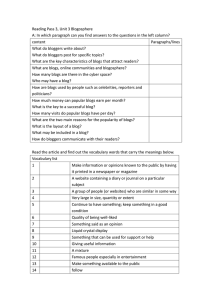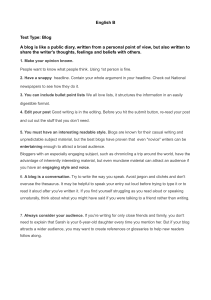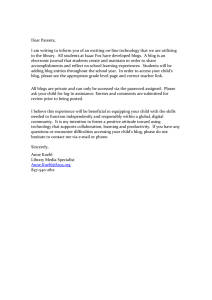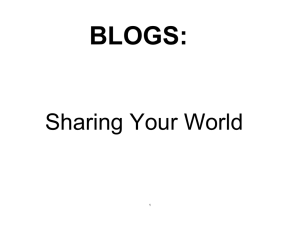Public Relations & Blogging in Zambia: University Assignment
advertisement
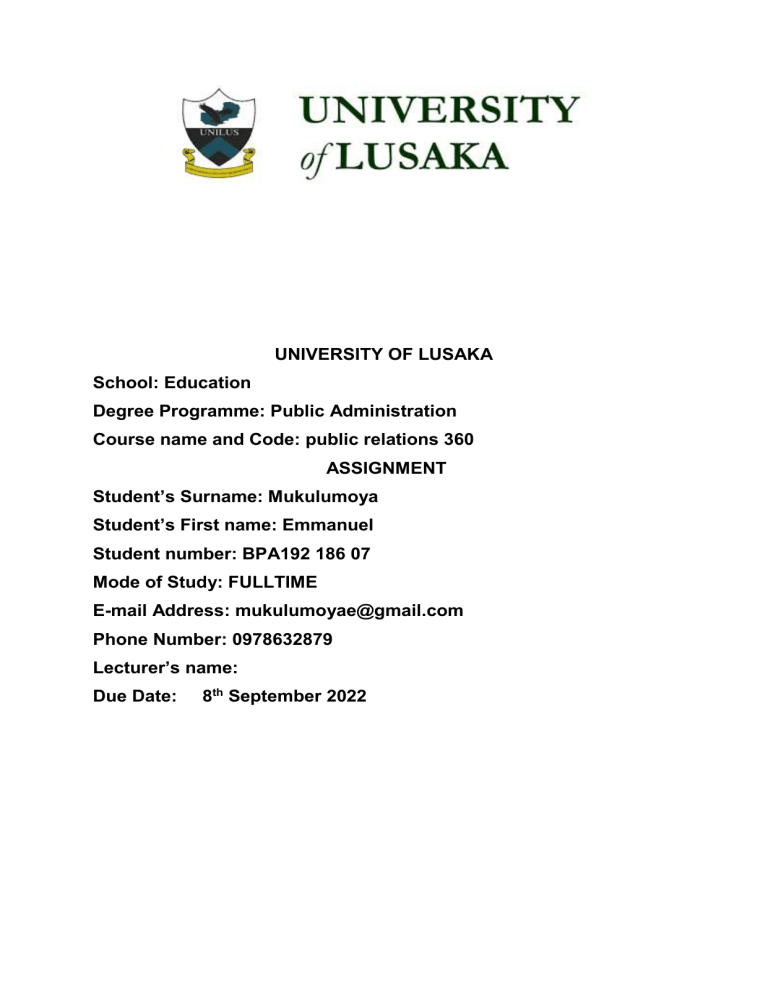
UNIVERSITY OF LUSAKA School: Education Degree Programme: Public Administration Course name and Code: public relations 360 ASSIGNMENT Student’s Surname: Mukulumoya Student’s First name: Emmanuel Student number: BPA192 186 07 Mode of Study: FULLTIME E-mail Address: mukulumoyae@gmail.com Phone Number: 0978632879 Lecturer’s name: Due Date: 8th September 2022 Contents Introduction ............................................................................................................................................. 3 1.0 Public relations, Bloggers and the Public and Private sector ............................................................ 3 1.1 Public sector .................................................................................................................................. 3 1.2 Private sector................................................................................................................................. 4 1.3 Public relations.............................................................................................................................. 4 1.4 Weblogging ................................................................................................................................... 5 2.0 Private sector and Blogging (case of Zambia) .................................................................................. 6 2.1 Blogging are here to stay .............................................................................................................. 7 2.2 Ownership of own media channel ................................................................................................. 7 2.3 Online reputation and presence ..................................................................................................... 7 2.4 Efficiency ...................................................................................................................................... 8 2.5 Behaviour influence ...................................................................................................................... 8 2.6 Consumers trust bloggers .............................................................................................................. 9 2.6 consumer company communication.............................................................................................. 9 2.7 Citizen Journalism ........................................................................................................................ 9 3.0 Blogging in Zambia’s public sector .................................................................................................. 9 3.1 The Government’s public relations department. ......................................................................... 10 3.2 Lack of competition .................................................................................................................... 10 3.3 Online reputation and presence ................................................................................................... 10 3.4 Ownership of own media channel ............................................................................................... 10 3.5 Efficiency .................................................................................................................................... 11 3.6 A blog is cost in the public sector ............................................................................................... 11 3.7 Crisis management ...................................................................................................................... 11 Conclusion ............................................................................................................................................ 12 References ............................................................................................................................................ 13 Introduction In the year 1994 Justin Hall a student at was responsible for creating the first blog, links.net. by then blogs were known by various different names one of the first being “personal home page” from there it changed to “open diaries”, it wasn’t until December 1997 when the official term “Weblog” came into existence the full word for blog which is now used today. From then blogs have been used by numerous individuals to share various types of information for various purposes one of them being the revolutionization of public relations. Therefore, this paper will focus on how bloggers have revolutionized public relations practice in Zambia’s private sector and including a comparative analysis of whether the same approach can be applied to the public sector. 1.0 Public relations, Bloggers and the Public and Private sector Before we can examine how bloggers have revolutionized the practice of public relation in the private sector and weather the same approach can apply to the public sector, it is imperative first define and briefly explain what public relation is, who a blogger actually is as well as what the public and private sector are. 1.1 Public sector The public sector is a segment of the economy that is purely public, according to (PrivacySense.net, 2016)The public sector is a part of the economy that comprises all organizations that are owned and operated by the government. This includes everything from schools and hospitals to roads and bridges. The public sector is comprised of the country’s governments and all agencies that or funded by the public this includes other enterprises and entities that responsible for the delivery of public goods and services and programs. The public sector is broader than just the government sometimes it overlaps with the non-profit sector or with the private sector. Simply put the public sector is more like a large continuously growing ring of numerous organizations with the government at the centre of it all, the in it is then followed public organizations and enterprises around them is a grey area consisting of contractors that are funded by the public and publicly owned businesses which may be but for the most part are not part of the public sector. 1.1.1 Levels of Public sector Public sector organizations may exist at any of four levels: International (multistate entities or partnerships). National (an independent state). Regional (a province/state within a national state). Local (a municipal-level body such as a city or county). The main purpose of the public sector is to ensure the welfare of the public through the provision basic goods and services. The public sector is to also protect and promote interest of weaker publics within a society and to promote development of the economy and infrastructure. 1.2 Private sector The part of national economy made up of private enterprises, it includes the personal sector (households) and corporate sector (Companies), and is responsible for allocating most of the resources within an economy; The segment of a country’s economy that is not controlled by the state government but is run by individual companies and individuals whose main purpose is to make profits. This sector is made up of all businesses that are independent and not in any way operated by the government their only allegiance is to their shareholders and their ultimate goal is profit maximization and being number one in their industry. 1.3 Public relations “The PR world of the 21st century has shaped and changed our understanding and usage of media and communication, and now extends itself to every continent and almost every country” (Siddiqui, 2014). Public relations are the practice concerned with the management of information and its circulation by an organization to the public for the purpose of affecting their perception, it also concerned with the maintenance favourable public image According to (Hayes, 2022) “Public relations (PR) is the set of techniques and strategies related to managing how information about an individual or company is disseminated to the public, and especially the media. Its primary goals are to disseminate important company news or events, maintain a brand image, and put a positive spin on negative events to minimize their fallout.” Public relations are the practice concerned with the management of information and its circulation by an organization to the public for the purpose of affecting their perception, it also concerned with the maintenance favourable public image. To many organizations it is seen as an of an organizations vital components weather that organization is in the public sector or the private sector, it plays the important role of communicating their messages to their investors, customers and the public as well as maintaining a good image. According to (satyendra, 2022) “public relations is responsible for the shaping and maintaining the image and reputation of the firm in the eyes of its various publics. It is the deliberate, planned and sustained effort to institute and maintain mutual understanding between the organization and its publics. It uses information to influence opinion for creating and maintaining goodwill.” Public relations in some way differs from ordinary advertising. Public relations practitioners do not purchase ads, write their stories for reporters, or focus their energies on attractive paid promotions. (Pahwa, 2022) Stated that “The main role of public relations is to promote the brand by using editorial content appearing in magazines, newspapers, news channels, websites, blogs, and TV programs. The main role of public relations is to promote the brand by using editorial content appearing in magazines, newspapers, news channels, websites, blogs, and TV programs. Using earned or free media for promotion has its own benefits as information on these mediums aren’t bought. It has a third-party validation and hence isn’t viewed with scepticism by the public.” The following are some of public relations important specific functions: The analysis, interpretation and prediction of the prediction of the publics opinions as well as attitudes towards the organizations brand and functions Handling the organization’s online presence on social media platforms and organization’s websites by responding to public reviews. Writing speeches and distribution of press releases. Formulation of crisis management strategies and implementation of strategies when a crisis arises. To handle all government and legislative agencies that may affect the organization in one way or another Dealing with investor relations Writing up content to be distributed on the internet (internal or external websites) 1.4 Weblogging 1.4.1 Blogger A blogger is an individual who ones and manages a blog, any person associated or works on a blog. A blogger writes regularly for an online website or journal providing information about a topic of interest, bloggers use these online journals to share own experiences, observation and opinions about a particular topic or product. A blogger is basically someone with his or her own platform, with which he or she has full control of it and no outside party has the ability to censor what is posted or what subject the blogger decides to cover. 1.4.2 Blog According to (Minaev, 2022) “In 1994, when blogs began, a blog was more of a personal diary that people shared online. In this online journal, you could talk about your daily life or share about things that you were doing. Then, people saw an opportunity to communicate information in a new way online. Thus began the beautiful world of blogging.” (gunn, 2021)“Most experts agree on the fact the first blog was Links.net, created in 1994 by then-student Justin Hall as a place to publish his writing. The site consisted entirely of brief posts, each one sharing a link and some of his thoughts on the content within. This collection of links included links to websites he liked, as well as his own work. The term blog is the short version of the word ‘weblog’, blog is the term used to describe an online journal or online diary or simply out information websites that displays the information that is posted by a blogger in a reverse chronological manner where the recently posted information appear at the top of the page and are the first to be seen by any reader who visits the page. There exist different types of blogs due to the content each blogger decides to post, such as food blogs for example will only concern food related topics reviewing quality of food being sold at a particular restaurant and many other such as business blogs, music health, travel etc 2.0 Private sector and Blogging (case of Zambia) Most organizations within the private sector have used blogs as one of their tools to enhance their public relations activities, public relations functions and the functions of a blog a similarity as they all share the same ultimate function which is the disseminations of information. A business type of blog is the type of blog mostly utilized by organizations to aid it in its public relations functions. “Blogging is a new form of online communication that is being used by companies as a PR tool. Today customers are moving away from the traditional media and so the need to be visible in the consumer’s eye, new media is essential.” (Pratap, 2017) Nowadays public relations have become more than just media relations, press release or even the launch of an organization or product related event, public relations strategies have been forced to evolve in order to cope with technological advances and the new type of customer who is much more aware of products with a more sophisticated taste, public relations now combine its traditional communication trends with a new 360˚ public relations strategies which of course include blogging. According to (Vžesniauskaitė, 2019) Blogs are able to reach those individuals with a taste for interesting pieces of news, non-traditional recommendations or educational material. 2.1 Blogging are here to stay In most countries blogging has become a part of an individual’s everyday life, with millions of blogs about any subject matter one could think of and bloggers with large number of following with the ability to shift public opinions, perception and ideas. According to (Fursdon, 2017) “Blogging a form of social media and is one of the fastest growing areas of communication in public relations practice? It has been argued that blogging is breaking down the barriers to communication, enabling more equal and democratic dialogue between individuals, groups and organisations”. It is this function that public relation was known for before the appearance of blogs in order to access such an ability Zambia’s private sector organizations and their public relation function have been forced to shift online and to use blogs in order to stay relevant or risk being left behind as humanity seem to have chosen blogs as major source of reliable information. 2.2 Ownership of own media channel Weblogs have now enabled firms to have their own media platform which has given firms the ability to become their own digital publisher in a very cost effective way of providing a modern digital public relations to its audience and information disseminated through blogs to their target audience in an easily accessible way which has helped firms gain loyalty from their audience who are its customers or potential customers, blogs have enabled firms to increase their loyal customers base and an increase in customers and customer loyalty results in an increase in private sector firm’s profitability 2.3 Online reputation and presence The Public relation process has the ultimate goal of enhancing an organizations image and reputations and through the use of blogs firms are now able to create a goon online reputation as well. An organizations online presence and reputation has a great impact on an organization’s brand or product as it will determine how the target audience will treat the brand or product (Goldsberry, 2016)“Guiding the conversation and demonstrating expertise about your product and industry will make you a trusted, go-to source, and customers need to trust the companies they do business with.” You can use blog posts to answer customers’ questions, solve problems and distinguish your company from the competition. with the internet of information individuals will not trust a brand or product if it has negative information surrounding it or no information about it at all, therefore having a blog as part of a firm’s public relations strategy enables an organizations to spread good news about their brand, product or image as well help counter act negative information, according to (Gleeson, 2015) when a consumer types your brand into search engine they receive negative results concerning your brand such as bad reviews and negative articles , you will need to combat the negative with other positive content or at least neutral and informative content. Therefore, building good relationships with bloggers in order for them to write about your company and its products has helped firms push down the negative search results. (Goldsberry, 2016) “Having a blog gives you the opportunity to deliver valuable content that others can share and repost on social media. It’s possible to use one blog post for numerous social media messages. When prospects see that you have useful information to share on social media, they will want to learn more by visiting your website, increasing your chances for conversion.” Public relation departments of a Firms nowadays don’t only seek a means to advertise their firms online but to do so while gaining a good online reputations and blogs are the most efficient way to achieve such a goal. 2.4 Efficiency Directly owning a blog or collaboration with a blog has helped firms in the profit-making sector get the most out of their public relations function cutting cost on advertising and news dissemination saving firms recourses and time. Due to the fact once information is posted on a blog page it's stays there forever until it is deleted, it stays there continuous driving traffic and it's able to be seen by any person who visits the blog without the need of an organization to keep pumping resources for the purpose of its circulation as it is easily accessible on the internet 2.5 Behaviour influence One of Public relations most important feature is its ability to affect public perception and opinion about a particular good, service, brand or topic. Firms use blogs to enhance this ability to increase their profitability. According to in today’s word blogs have become the new version of the word-of-mouth studies have shown that 84% of consumers are more likely to purchase a product or service after reading about it on a blog in addition to this statistic people that are between the ages of 15 and 54 have ranked blogs to be one of their most important sources of information before making a purchase of any good or service. Therefore, blogs have changed the way in which organization’s public relations influence the consumer through the use of blogs. 2.6 Consumers trust bloggers Private sector organizations have become aware that their consumers have gone through a sort of awakening and don’t just accept any product or service from just any firm, as a result public relation utilizes the bloggers as they themselves are also considered as consumers are no part of the organization in most cases. Consumers are more likely to trust blogger as they are not a company’s mouth piece hence their opinions and experiences are not bias and are truthful as compared to the information and/or advertisements that come directly from the company itself. The public relations function of an organization has changed in the way it gains consumer trust because of blogs. 2.6 consumer company communication Blogs have given firms the opportunity to communicate with their consumers but this opportunity brings about responsibility. As these platforms have come to raise customer service expectations. Only in a past where a consumer could interact with a firm during business hours, from Monday to Friday. Consumers can now interact 24 hours of the day and 7 days of the week with the firm and the firm is expected to respond. “In order to accommodate these customer demands, many brands have extended their social monitoring hours to nights and weekends. Since news and hot issues often break on social media, brands that monitor their social channels closely and address these issues swiftly and tactfully can control the conversations, rather than reacting to them.” (Matter comunications inc, 2022) 2.7 Citizen Journalism Blogs have given ordinary citizens the platform to share and voice their opinions making them powerful influencers of organization brands and image bloggers are sought out public relations professionals from organizations who do not have blog of their own for the purpose of collaboration due to the effectiveness of blogs in reaching a target audience the have become a necessity to the public relations function with in an organization as bloggers can create a meaningful relationship between consumers and firms. 3.0 Blogging in Zambia’s public sector Bloggers have been a key factor in the evolution of public relations as they have revolutionized and changed the way public relations functions are carried out, however this change is only happening in organization the private sector and not as much in the public sector. Because the function of public relations remains the same in any sector which is to affect the opinions of the publics and create good relationship between them and the publics, bloggers cannot enhance the way public relations is carried out within the public sector due to the following issues. 3.1 The Government’s public relations department. Zambia’s main government has its own public relations department in which it uses to disseminate information about its workings to the nation’s citizens, according to (National assembly of Zambia, 1924) “The core function of the Public Relations Department is to provide citizens with information about the activities of the parliaments mainly through the press, mass media and visits to Parliaments by the public.” Zambia’s public relations department has not gone through any kind of revolution due to bloggers as it has been stated the parliament only uses press media and visits to parliament and no such mention of the internet or blogs. 3.2 Lack of competition The private sector of the economy consists of a large number of firms each different industry all competing for a greater market share and to maximize their profitability hence they have to stay relevant and use every efficient tool in their disposal such as the biggest one of them all the internet where blogs are becoming an effective way of reaching and influencing consumers. However, this different in the public sector as most public sector organizations in Zambia have no competition the services which are provided by the are financed through tax there is no need to go out of their way to advertise through blogs online because it would not make much of a difference to them. It is due to these reasons public sector public relations only focuses on ordinary media dissemination methods. 3.3 Online reputation and presence The existence of monopolies in certain industries in Zambia for example ZESCO ltd, is one of the organizations public relations department do not have the drive to create a good personal and online reputation or maintain an online presence not having to worry whether its competitors are reaching a greater audience online through blogs, especially if what is being provided by that organization is an essential service, it does not mater to the consumers whether they use a blog or not they will still need the organizations product and cannot boycott it, public relations using blogs will only be seen as an extra cost the organization the departments main function will be to manage crisis when it arises and to provide press releases 3.4 Ownership of own media channel Having a platform in which an organization can publish content about itself is or collaborating with a writer that has his or her own platform being a blog page is very useful to an organization. But not so much if that organization is the government because most of the content in newspapers, radios and news stations on televisions such as ZNBC is about the government and organizations its connected to within the public sector. Content about government activities programs products and services is not hard to find there is little or no need to create a blog to help public relations, Blogs can provide an organization with its own digital space for its content but in Zambia’s public sector such an effort would. 3.5 Efficiency Bloggers have revolutionized the way organization’s public relation strategies are carried out as they are an effective and efficient way to disseminate information about anything saving time and resources and it is this cost effective feature that has made blogs popular in the private sector however in the public sector a distribution network for information and content about public sector firms the government has already been established the government owns it own television station radio stations and does not have to pay for its content to be broadcasted. Public sector organizations benefit from such arrangements therefore eliminating the need for the blog approach in their public relation strategy. 3.6 A blog is cost in the public sector A blog is only as effective as the person managing it only as effective as the person managing it, because of the fact that government and most public institutions have very little interest in content posting on the internet for them to introduce blogging to their public relations strategy this would require them to seek out such specialist when it comes to blogging. “A blog will only be useful to an organization if It has someone to maintain it, someone trained in effective dialogic communication, and someone who has the trust of individuals and publics. Posting anonymously to blogs is not a viable option for any organization nor are attempts to manipulate blog audience members with self-serving propaganda or thinly disguised news releases” (Fursdon, 2017). Doing all that will cost the firm money and time and would seem to be unnecessary because they can just use the traditional media platforms that are already available to them. 3.7 Crisis management The public relations function can utilize a blog whether it is in the public or private sector a public sector organization can use a blog as one time solution to manage a crisis as blogs are very effective as a blog is faster and can be temporary or permanent allowing the company to quickly face the issue and once it passes the post can be deleted Conclusion Due to the large number of technological advancement individuals are now able to share their own opinions about anything from products to services through affecting the way organizations perform because of this firms in the private sector have been forced to seek out these individuals with blogs or to create on of their own this has become part of an organization’s public relations strategy forever changing how the public relations department in the private sector affects the public opinion and perception however this phenomena has not yet fully affected organizations in Zambia’s the public sector even though it would revolutionize the relationship between the consumers and the firms the public sector is still lacking in technological integration. References Fursdon, R., 2017. Revistia. [Online] Available at: https://revistia.org/files/articles/ejis_v3_i3_17/Leena.pdf [Accessed 1 september 2022]. Gleeson, B., 2015. Forbes. [Online] Available at: https://www.forbes.com/sites/brentgleeson/2015/01/14/how-blogging-changed-thepr-game-what-executives-need-to-know-part-1/?sh=27fd3d368062 [Accessed 3 september 2022]. Goldsberry, L., 2016. AXIA public relations. [Online] Available at: https://www.axiapr.com/blog/4-ways-blogging-can-improve-your-pr-efforts [Accessed 02 september 2022]. gunn, D., 2021. Themeisle. [Online] Available at: https://themeisle.com/blog/history-of-blogging/ [Accessed 29 august 2022]. Hayes, A., 2022. Investopidia. [Online] Available at: https://www.investopedia.com/terms/p/public-relations-pr.asp [Accessed 5 September 2022]. Matter comunications inc, 2022. matternow. [Online] Available at: https://www.matternow.com/blog/3-ways-social-media-has-changed-public-relations/ [Accessed 8 september 2022]. Minaev, A., 2022. FirstSiteGuide. [Online] Available at: https://firstsiteguide.com/what-is-blog/ [Accessed 7 september 2022]. National assembly of Zambia, 1924. Parliament.org. [Online] Available at: https://www.parliament.gov.zm/node/162 [Accessed 8 september 2022]. Pahwa, A., 2022. Feedough. [Online] Available at: https://www.feedough.com/what-is-public-relations-pr-functions-types-examples/ [Accessed 7 september 2022]. Pratap, D., 2017. revistia. [Online] Available at: https://revistia.org/files/articles/ejis_v3_i3_17/Leena.pdf [Accessed 5 september 2022]. PrivacySense.net, 2016. PrivacySense.net. [Online] Available at: https://www.privacysense.net/terms/public-sector/ [Accessed 30 August 2022]. satyendra, 2022. ispatguru. [Online] Available at: https://www.ispatguru.com/author/satyendra/ [Accessed 1 9 2022]. Siddiqui, Z., 2014. PR insider. [Online] Available at: https://www.curzonpr.com/theprinsider/from-the-beginning-the-history-of-pr/ [Accessed 28 august 2022]. Vžesniauskaitė, A., 2019. PRGN. [Online] Available at: https://prgn.com/pr-tips-trends/why-should-blogging-be-a-part-of-your-pr-strategy/ [Accessed 7 September 2022].

